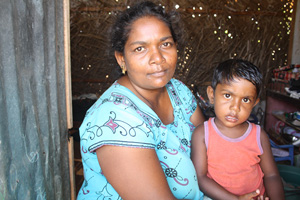Ilankai Tamil Sangam29th Year on the Web Association of Tamils of Sri Lanka in the USA |
|||||||||
 Home Home Archives Archives |
Focus on Food Insecurity in Jaffnaby IRIN Asia, Bangkok, July 9, 2012
JAFFNA, 9 July 2012 (IRIN) - In Sri Lanka’s northern Jaffna District, Parameswary Rasakumar, 32, a mother of two, points to an assortment of red plastic containers on the floor of her makeshift shelter, holding what little food the family has. “That’s it. That’s all the food we have in the house at the moment.”
Her husband works as a casual day labourer. “We no longer get any food assistance from the government and now have to buy food on credit. When my husband doesn’t work we go without.” A lack of basic services, including water supply and sanitation, is exacerbating living conditions.
The preliminary findings of a 2012 comprehensive food security assessment (CFSA) by WFP, yet to be released, indicate that 44 percent of households in the five districts of Northern Province are food insecure (37 percent moderately food insecure and 7 percent severely food insecure). A similar survey by WFP and the government in 2011 found over 60 percent of households in Northern Province were food insecure (46 percent moderately food insecure and 15 percent severely food insecure). "While there have been improvements, without doubt, food insecurity continues to be a serious cause for concern across pockets of the north. People there are really struggling," said Julia Vasconcelos, head of WFP's area office for Northern Province, citing rising food prices, lack of job opportunities, and high levels of poverty as contributing factors. Among the 3,800 households interviewed across eight districts in the north and east - Jaffna, Kilinochchi, Vavunya, Mullaitivu, Mannar, Trincomalee, Batticaloa, and Ampara - food insecurity was particularly pronounced in Jaffna. At present 55 percent of Jaffna residents are food insecure (44 percent moderately food insecure and 11 percent severely food insecure). Of the 111,457 families now classified as food insecure in the five northern districts more than 65 percent, or 73,404 families, are in Jaffna. While overall poverty levels across the north have dropped in the past year, 55 percent of households in Jaffna continue to live under a poverty line of less than US$1 per day per person, the findings revealed. Fruit, vegetables, and other food are readily available in the local market, but “People simply don’t have the money [to buy enough food],” said Rashkarn Marthraja, a butcher in Jaffna. The price of rice, a staple part of the Sri Lankan diet, has remained largely stable, but prices for dairy products, meat and other items have seen a dramatic increase. “Last year a kilo of meat cost 700 Sri Lankan rupees (US$5.23). Today it costs 1,100 rupees ($8.22),” he said.
By comparison, Kilinochchi District, once the heartland of the conflict, has reported a significant drop in the number of food insecure people, from 84 percent (54 percent moderately food insecure and 30 percent severely food insecure) in 2011, to 24 percent (22 percent moderately food insecure and 2 percent severely) in 2012. An increased intake of fruit, dairy and meat products have improved people’s diets in the area, the CFSA noted. Food experts cite the recent economic boom in the area, coupled with lower levels of poverty, as some of the reasons. The prospects of similar improvement for the residents of Jaffna will require more time and livelihood support; a fact the Sri Lankan government is well aware of. “Livelihoods remain problematic in Jaffna, and this is undermining the food security situation,” Suntharam Arumainayaham, the Government Agent and most senior official in Jaffna, told IRIN. “This is where we need the most assistance and support.” According to WFP’s recent findings, 38 percent of households in Jaffna report using credit to meet their food expenditures, while 90 percent report at least one family member or more unemployed or actively looking for a job. ds/he
| ||||||||


